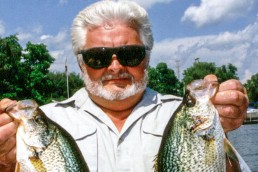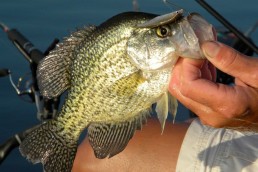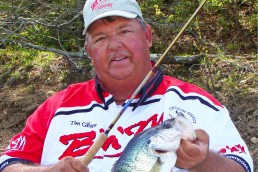Now is the time for Crappies on Lake Wisconsin
SHARE THIS POST
If you’re looking for some eating-size crappies and some larger slabs, then Columbia County’s Lake Wisconsin is the place to go in the spring and early summer. We all know that this has been a tough spring. Inconsistent weather and high water have made most fishing average at best. But, the weather looks like it is going to change for the better. Hopefully that means better fishing for all species.
Lake Wisconsin is actually a flowage, which was formed when the Wisconsin River was dammed at Prairie du Sac and Wisconsin Dells. The lake or flowage is over 5,000 acres with a constant flow of water passing through and replacing the lake’s water every four days during normal flow periods.
The magic mark for crappies
Crappie fishing starts soon after the ice leaves the lake in late March and April (in a normal year) and steadily improves after the water temperature hits the “magic” 50-degree mark. Lake Wisconsin has plenty of good crappie structure in its numerous shallow bays with dark bottoms that the sun warms, quickly attracting hungry crappies. Crappies will move into the bays for the warmer water and forage in the spring and later spawn when the temperature reaches the low to mid 60’s. Concentrate your efforts near brush piles, around any shoreline cover, by fallen trees, and around and under docks and piers. There are a few scattered weeds in some bays, but the constant water flow prevents weeds from growing in most of the lake.
The average-size crappie is about 10 inches, but there are many larger fish. Some days, most of the crappies that you’ll catch will be over 12 inches or longer. These larger crappies are usually spawning females. Try not to take too many of them. They are the brood stock for future years. It’s not unusual to catch numerous fish in the 12 to 15-inch range and larger ones are possible.
Lake Wisconsin has numerous older wooden piers in some of the lake’s bays. The piers provide shade, cover, forage, and the wooden piers warm much more quickly than the metal piers. That helps warm the nearby waters. The wooden piers also seem to hold more fish earlier. The wood gets algae growing on them. That algae soon attracts small insects and bugs and gets the food cycle going for the hungry crappies. The number of wooden piers is diminishing, due to the development of many new homes which are usually building metal piers. The “old days” of wooden docks are constantly disappearing because of the continued development. Also, much of the brush and wood is also being cleared from the bay’s shoreline. This takes away much of the crappie habitat. So, when you find wood, timber or brush in any of the bays, fish that area. You’ll most likely find crappies.
Hot spots to hit
Weigands Bay is divided into north and south bays. There’s an old pump house (light blue) that splits the bay. Stay to the left, go to the back of the bay and fish all the fallen trees and piers that you can find. There is also some deeper water in the back of the bay where spring crappies will suspend if the weather cools.
Moon Valley is at the north end of the lake and warms quickly in the spring. There’s a shallow stump field at the entrance to the bay that holds crappies. Try fishing the bay’s many cribs in about seven feet of water. If you go through the bay at Moon Valley, there’s an underpass under Highway 78 that takes you into Gallus Slough. This shallow and weedy slough has both crappies and bluegills, so fish it in the spring and early summer before it becomes weed choked.
Okee Bay is a spot that has many cribs and slack water that holds crappies in the spring and into the summer. The water around the Okee Bridge is an excellent early spot for walleyes with shore anglers catching crappies too.
Sticky Bay, at the east end, has four fingers or boat channels that are shallow and have crappies throughout the spring and spawning period. The channels have limited early weed growth and a few piers, so this is another location worth fishing.
Are you enjoying this post?
You can be among the first to get the latest info on where to go, what to use and how to use it!
Sunset Bay is another quality location with a few weeds, some cribs and even some wooded stumps on the bay’s west side.
Lake Wisconsin also has cribs scattered around the lake, put there by the DNR to act as fish attractors and structure for crappies and other fish species. The cribs are easily marked on your electronics. Some areas to look for them are: near Tipperary Bluff, Stoners Point, Breezy Point, Pine Bluff, Moon Valley, and Weigands Bay.
Muck makes for good fishing
The water in most of the bays is stained, with a muck bottom that warms early and attracts food for the spawning crappies. Crappies move in and out of the bays, depending on the weather. When the weather is nice and sunny, you can find Lake Wisconsin crappies in two or three feet of water near any structure like wood, piers and shoreline brush. You don’t have to start fishing early in the morning. The crappies like to wait until the water starts warming in the mid morning. The best time in the spring and early summer to crappie fish is during the middle of the day, if the weather is stable. If you have a stretch of up-and-down weather, try fishing a little deeper. Crappies will move in and out of spawning areas depending upon the weather.
The equipment needed to catch crappies in Lake Wisconsin is nothing special or expensive. A 6.5-foot graphite rod is ideal. It allows you to make long casts and not spook shallow-water crappies. Next, you need a good-quality spinning reel (Daiwa or Garcia) and spooled with 4-pound Berkley Trilene. Green blends in well with the lake’s stained water. The 4-pound-test mono works better than 6 pound for these spring fish.
I’d then use a slip bobber or float with a small split shot and an ice-fishing jig (have a good assortment in different sizes and colors) tipped with a few wax worms or spikes. Black has seemed to be an underused color on Lake Wisconsin. The nice thing about a slip bobber is that you can change depths easily when searching for crappies that have moved or even suspended over deeper water. Make long casts and slowly work your rig back, topping and letting the bobber rest now and then.
Another rig that will work well is a # 8 VMC hook fished below a Thill “mini-stealth” float and baited with a crappie minnow. The last rig that I’ll suggest is to fish a one-inch tube jig below a round float. Set the minnow 15 to 30 inches below the float and cast the shoreline, twitching the minnow back to the boat or shore.
Be sure to bring some different-size crappie minnows. Fish want different size bait at different times. Another option that works well on active fish is small plastic noodles or wedges in assorted colors and dressed with a wax worm or two. The old standard “pinkie jig” and minnow under a float still works well!
All that is now needed is stable weather and warming sunshine. The “slabs” will be active on the lake, so why not give Lake Wisconsin a try? The immediate area has everything that you need: motels, resorts, eateries, campgrounds, boat rentals, and bait shops. The boat landings are good, numerous and give you access to any lake location. This is the time to fish Lake Wisconsin crappies!
MWO
SHARE THIS POST
Did you enjoy this post?
You can be among the first to get the latest info on where to go, what to use and how to use it!
Gary Engberg
If you have any questions or comments you may reach Gary Engberg at 608-795-4208 or garyengbergoutdoors.com.



